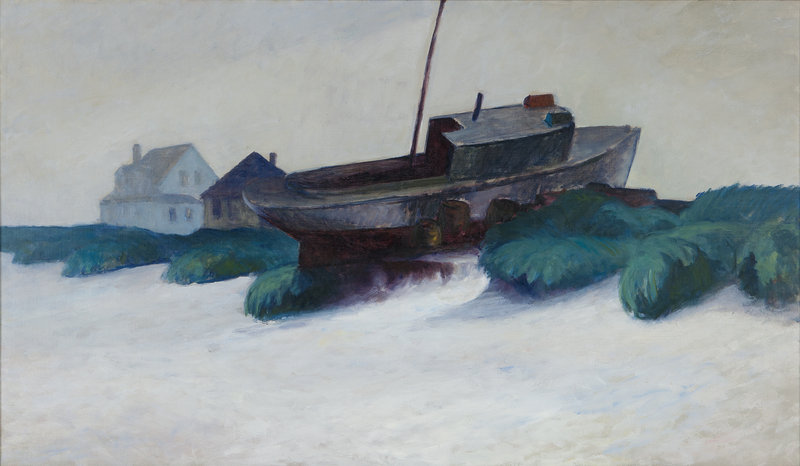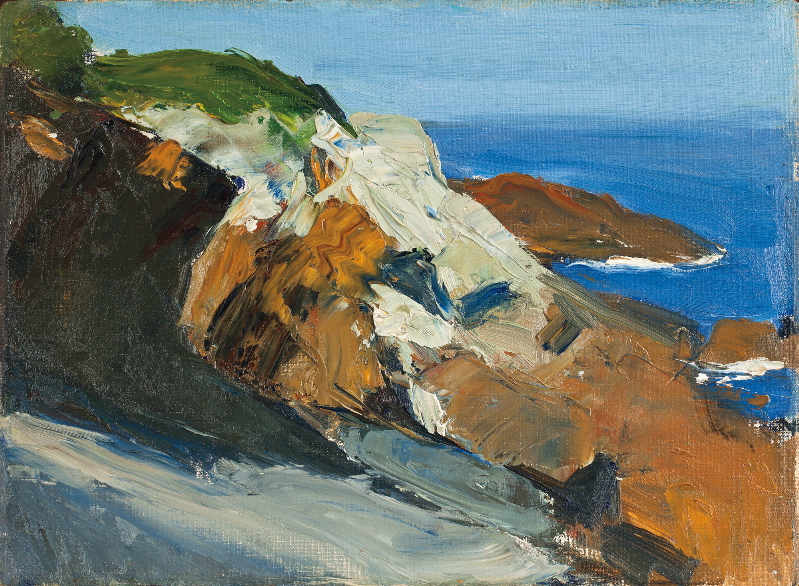BRUNSWICK — Edward Hopper came to Monhegan Island over four summers, from 1916 to 1919.
During that time, we know that he made 32 paintings on the island. They are finished oil-on-panel studies, most of them measuring no larger than 12 by 16 inches. Hopper painted on location and chose tight, focused views of the island’s rugged landscape, concentrating on Monhegan’s rocky terrain.
This summer, the Bowdoin College Museum of Art is exhibiting 30 of Hopper’s 32 Monhegan paintings. It’s believed to be the first time so many have been exhibited together at once. Bowdoin hoped to display all 32, but one is traveling in another exhibition and is unavailable, and the other is privately owned, its whereabouts unknown.
The 30 Monhegan paintings are part of Bowdoin’s ambitious exhibition, “Edward Hopper’s Maine.” It includes almost 90 pieces of artwork — oil paintings, watercolors, drawings and a handful of prints. Collectively, the Bowdoin show represents about two-thirds of the work that Hopper completed with Maine as his subject, and perhaps as much as one-seventh of his lifetime output as an artist.
As such, the show provides an almost complete examination of a critical period in the career of one of America’s most prominent and beloved Realist painters.
Hopper spent nine summers in Maine over a 16-year period, from 1914 to 1929. He started in Ogunquit, went to Monhegan, and then worked his way around the southern and midcoast, painting in Rockland, Cape Elizabeth, Portland and on the Pemaquid peninsula.
ON TO WARMER CLIMES
Beginning in 1930, Hopper moved his concentration south to Cape Cod in Massachusetts, because it got “too cold too fast in Maine,” said Kevin Salatino, director of the Bowdoin College Museum of Art and co-curator of the exhibition. “But in the end, I think everything that Maine could give him, it gave him.”
And what a gift it was.
In Maine, Hopper found and developed the iconic style for which he became famous. Prior to coming here, he worked as an illustrator in New York. He loathed his workaday career, said Diana Tuite, Bowdoin’s curator.
Maine offered an escape from a job he hated, a break from New York’s stifling summer heat and the chance to express himself as an artist.
He was attracted to the colors of Maine, its light and the way the buildings and man-made architecture played against the landscape. The common features of American life that defined his well-known later work had it roots in Maine, and are evident in the Bowdoin exhibition.
In this show, we see dories on the water at Ogunquit, lonely country roads with power poles bisecting the landscape, railroad tracks rumbling through town, and urban mansions.
“Edward Hopper’s Maine” includes his familiar lighthouse paintings from Cape Elizabeth and Pemaquid Point, as well as the pictures of the Victoria Mansion in Portland and the Methodist Church on what is now Route 77 in Cape Elizabeth.
“I think people are going to be surprised with this show,” Salatino said. “While they’ll be familiar with some of the famous Maine paintings, they will not be familiar with the Monhegan and Ogunquit paintings.”
Those lesser-known works, which are rarely exhibited, are “voluptuous. They’re like cake icing. You want to lick the icing right off the cake,” he said.
Ogunquit offered Hopper his first exposure to Maine. He came in the summers of 1914 and 1915, by which time Ogunquit was widely known as an artist colony. As were those who came before him, Hopper was drawn to the boats, coves and beaches.
The Bowdoin exhibition has seven oils from Ogunquit, five of which riff on the theme of rocks, water and coves. In three of those, he includes dories, the flat-bottom fishing boats. Another depicts an inviting country road in brown and green, and the final Ogunquit painting shows a cluster of homes partially hidden by rock outcroppings.
In 1916, Hopper began his annual Monhegan pilgrimages. If Ogunquit lured painters with its fishing villages and easy access to quaint coastal scenes, Monhegan offered something else altogether. This was hard-to-reach rugged terrain — dramatic in its scope and character.
AWED BY MONHEGAN’S GRANDEUR
The trail of artists coming to Monhegan was well worn by the time Hopper arrived for the first time in 1916, but it was nothing like Ogunquit. Monhegan was still fresh, and Hopper devoured the landscape.
These 30 Monhegan oils suggest he was awed by the sea and the steep, dangerous cliffs. They are specific and focused — single boulders and coves, with waves crashing on the rocks. There is one village painting, one scene of three dories at water’s edge and one painting of trees running along a path and fence line.
Otherwise, almost everything else suggests precipitous granite cliffs. They are not unlike Monet’s haystacks, a concentration on a single subject.
Hopper painted Realist depictions of actual places, but these paintings seem to have more to do with shape, form and color than a specific time or place. Some are almost anti-picturesque. “They are closer to abstraction than he ever did before or again,” Salatino said.
Maine also gave Hopper a chance to exercise his skills as a watercolorist. The Bowdoin show has 34 watercolors from 1926-27 and 1929, from Rockland, Portland, Cape Elizabeth and Pemaquid. Some have been shown in Maine recently, but their inclusion in the Bowdoin show is important, because they help tell the complete story of Hopper’s time in Maine.
One other notable painting in this show is “Maine in Fog,” an unsigned oil painting that Hopper made between 1926 and 1929. The Whitney Museum owns it, but Salatino said the Whitney has never included it in a major Hopper show.
For many years, the mysterious painting was believed to be unfinished. But Salatino said new information suggests that is indeed a finished piece of work, and its inclusion in the Bowdoin show represents “a major Hopper discovery.”
“Edward Hopper’s Maine” includes an interactive map on the museum’s website. Viewers can click on locations in Maine where Hopper painted, and compare the finished work with a present-day photo from the location where Hopper made the painting.
Staff Writer Bob Keyes can be contacted at 791-6457 or at:
bkeyes@pressherald.com
Follow him on Twitter at:
Twitter.com/pphbkeyes
Send questions/comments to the editors.






